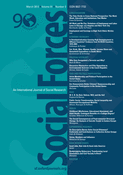-
Views
-
Cite
Cite
Colin J. Beck, Emily Miner, Who Gets Designated a Terrorist and Why?, Social Forces, Volume 91, Issue 3, March 2013, Pages 837–872, https://doi.org/10.1093/sf/sos200
Close - Share Icon Share
Abstract
This study examines formal terrorism designations by governments through the lens of organization studies research on categorization processes. It is argued that designations hinge on markers from the organizational profile of a militant group. Using cross-sectional data on militant organizations and designations by the United States, the United Kingdom and the European Union, multivariate analyses find that listed organizations do not merely have a track record of violence against a government's citizens, but also tend to target aviation and have an Islamic ideological basis. Mixed support for geopolitical factors is found, but imageries of hegemonic interest are not confirmed. Secondary analyses suggest that newer images of terrorism may replace older ones in classification schemes but further research is needed to know whether this is because of policy adaptation or the effect of spectacular events like September 11th.



